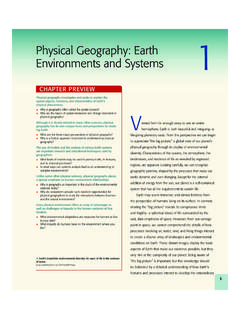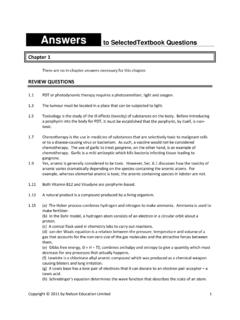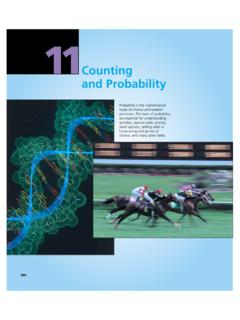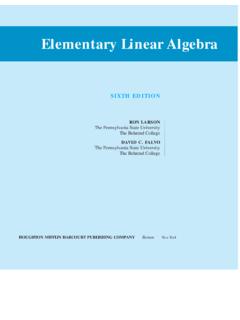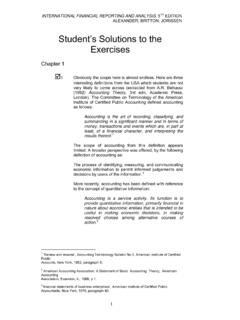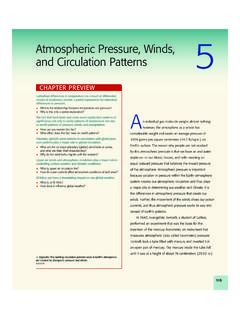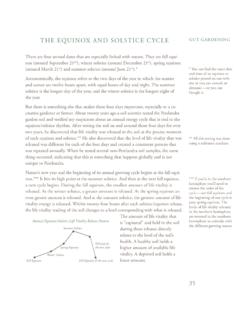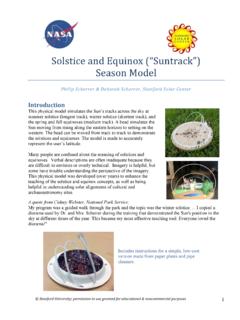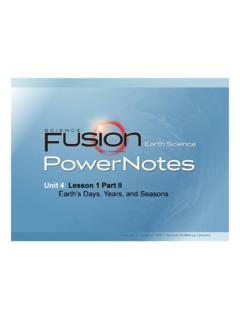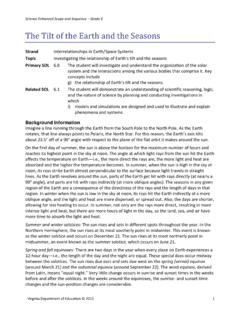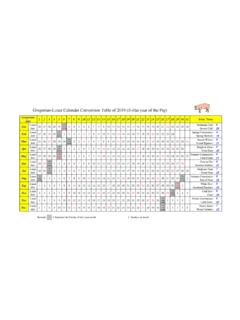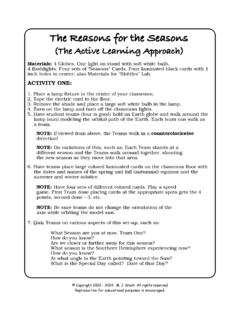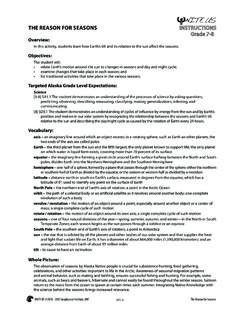Transcription of Sun Angle, Duration, and Insolation - Cengage
1 74 C H A P T E R 3 E A R T H S U N R E L AT I O N S H I P S A N D S O L A R E N E R G Y. one time varies from place to place because Earth presents a 23 12 . spherical surface to Insolation . Therefore, only one line of lati- tude on the Earth's rotating surface can receive radiation at right angles, while the rest receive varying oblique (sharp) angles ( Fig. ). As we can see from Figure and c, solar 66 2 . 1. energy that strikes Earth at a nearly vertical angle renders more intense energy but covers less area than an equal amount striking Earth at an oblique angle. Eq The intensity of Insolation received at any given latitude ua tor Sun can be found using Lambert's Law, named for Johann Lambert, an 18th-century German scientist.
2 Lambert developed a formula by which the intensity of Insolation can be calculated using the Plane of ecliptic 23 12 sun's zenith angle (that is, the sun angle deviating from 90 di- Plane of rectly overhead). Using Lambert's Law, one can identify, based equator on latitude, where greater or lesser solar radiation is received on 66 2 . 1. Earth's surface. Figure shows the intensity of total solar Axis energy received at various latitudes, when the most direct radia- FIGURE tion (from 90 angle rays) strikes directly on the equator. The plane of the ecliptic is defined by the orbit of Earth around the sun.
3 In addition, the atmospheric gases act to diminish, to some ex- The 23 inclination of Earth's rotational axis causes the plane of the tent, the amount of Insolation that reaches Earth's surface. Because equator to cut across the plane of the ecliptic. oblique rays must pass through a greater distance of atmosphere How many degrees is Earth's axis tilted from the vertical? than vertical rays, more Insolation will be lost in the process. In 1854, German scientist and mathematician August Beer estab- lished a relationship to calculate the amount of solar energy lost as it comes through our atmospheric gases.
4 Beer's Law, as it's called, is strongly affected by the thickness of the atmosphere through which sun angle , duration , the energy must pass. and Insolation Since no Insolation is received at night, the duration of solar energy is related to the length of daylight received at a particular Understanding Earth's relationships with the sun leads us directly point on Earth (Table ). Obviously, the longer the period of into a discussion of how the intensity of the sun's rays varies from daylight, the greater the amount of solar radiation that will be re- place to place throughout the year and into an examination of the ceived at that location.
5 As we will see in our next section, periods seasonal changes on Earth. Solar radiation received by the Earth of daylight vary in length through the seasons of the year, as well system, known as Insolation (for incoming solar radiation), is the as from place to place, on Earth's surface. main source of energy on our planet. The seasonal variations in temperature that we experience are due primarily to fluctuations in Insolation . What causes these variations in Insolation and brings about The Seasons seasonal changes? It is true that Earth's atmosphere affects the Many people assume that the seasons must be caused by the amount of Insolation received.
6 Heavy cloud cover, for instance, changing distance between Earth and the sun during Earth's will keep more solar radiation from reaching Earth's surface than yearly revolution. As noted earlier, the change in this distance will a clear sky. However, cloud cover is irregular and unpredict- is very small. Further, for people in the Northern Hemisphere, able, and it affects total Insolation to only a minor degree over Earth is actually closest to the sun in January and farthest away long periods of time. in July (see again Fig. ). This is exactly opposite of that hemi- The real answer to the question of what causes variations sphere's seasonal variations.
7 As we will see, seasons are caused in Insolation lies with two major phenomena that vary regularly by the 23 tilt of Earth's equator to the plane of the ecliptic for a given position on Earth as our planet rotates on its axis and (see again Fig. ) and the parallelism of the axis that is main- revolves around the sun: the duration of daylight and the angle tained as Earth orbits the sun. About June 21, Earth is in a posi- of the solar rays. The amount of daylight controls the duration tion in its orbit so that the northern tip of its axis is inclined of solar radiation, and the angle of the sun's rays directly affects toward the sun at an angle of 23.
8 In other words, the plane of the intensity of the solar radiation received. Together, the inten- the ecliptic (the 90 sun angle ) is directly on 23 N latitude. sity and the duration of radiation are the major factors that af- This day during Earth's orbit is called the summer solstice (from fect the amount of Insolation available at any location on Earth's Latin: sol, sun; sistere, to stand) in the Northern Hemisphere. surface. We can best see what is happening if we refer to Figure , Therefore, a location on Earth will receive more insola- position A. In that diagram, we can see that the North- tion if (1) the sun shines more directly, (2) the sun shines lon- ern and Southern Hemispheres receive unequal amounts ger, or (3) both.
9 The intensity of solar radiation received at any of light from the sun. That is, as we imagine rotating Earth 55061_03_Ch03_p064_083 74 6/5/08 11:17:50 PM. S U N A N G L E , D U R AT I O N , A N D I N S O L AT I O N 75. Arc tic Cir cle Equ Tro Sun ato p ic o r fC. anc er Tro Sun's vertical rays pic o fC. apr ico rn An tarc tic Cir cle Sun's oblique rays (a). 1 m2. 1 m2. 73 . 26 . m2 m2. (b) (c). FIGURE (a) The angle at which the sun's rays strike Earth's surface determines the amount of solar energy received per unit of surface area. This amount in turn affects the seasons. The diagram represents the June condition, when solar radiation strikes the surface perpendicularly on the Tropic of Cancer, creating summer conditions in the Northern Hemisphere.
10 In the Southern Hemisphere, the sun's rays are more oblique and spread over larger areas, thus receiving less energy per unit of area, making this the winter hemisphere. How would a similar figure of Earth sun relationships in December differ? The sun's rays in summer (b) and winter (c). In summer the sun appears high in the sky, and its rays hit Earth more directly, spreading out less. In winter the sun appears low in the sky, and its rays spread out over a much wider area, becoming less effective at heating the ground. under these conditions, a larger portion of the Northern Hemi- the Southern Hemisphere.




